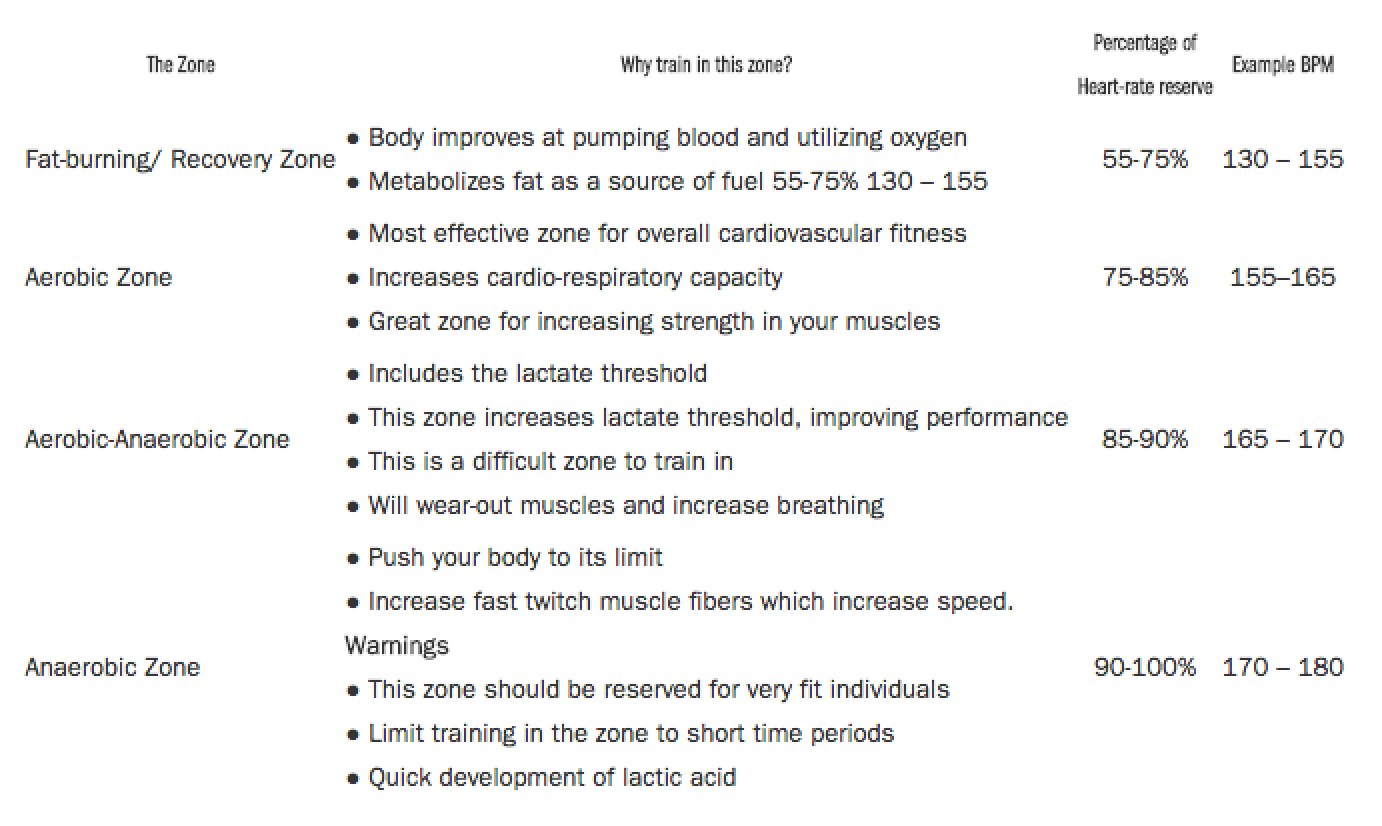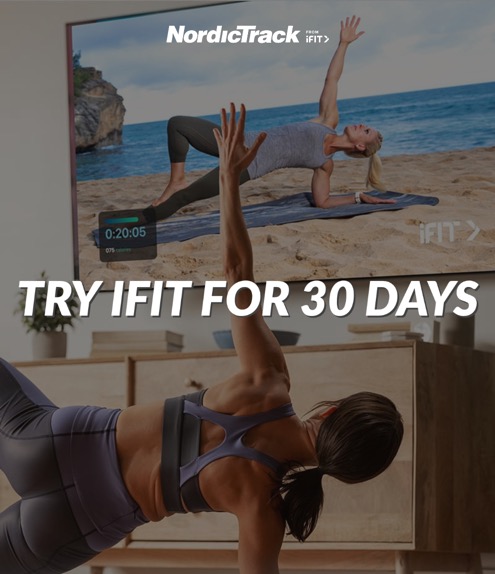
The heart is the core of the body, and it provides us with great information on how our body is doing while we exercise.
It’s important to know how to calculate your optimal heart rate zones, understand the meaning of those zones, and also how to leverage that information in training to meet specific fitness goals.
Calculating Your Reserve Heart Rate So You Can Determine Your Optimal Heart Rate Zones
Our heart rate range can be broken into several zones. We’ll discuss four of those here:
- Ideal fat-burning zone
- Aerobic fitness zone
- Aerobic-Anaerobic zone
- Anaerobic zone.
To determine these zones, we first need to calculate our heart-rate reserve. To do this you would do these:
- Calculate your maximum heart rate by subtracting your age from 220. This gives you your age predicted maximum beats per minute.
Example: If your age was 40, you would subtract 40 from 220 and 180 bpm would be the maximum rate. - Calculate your resting heart rate by taking your pulse when resting. An ideal time to do this is when arising in the morning.
Example: Your resting heart rate might be 80 bpm. - Calculate your heart-rate reserve by subtracting the resting rate from the maximum rate.
Example: 180 bpm – 80 bpm = 100 bpm. This is the number we’ll be working with to calculate your four heart rate zones for exercising.
Calculating Your Goal Specific Target Heart Rate Zones
Fat-Burning Zone
The name “fat-burning zone” can be misleading. We burn fat in all the zones; however, we do it best in this zone. Your ideal heart rate for burning fat is calculated as follows:
(Reserve x 0.5) + Resting = Low End of Fat-Burning Zone
(Reserve x 0.75) + Resting = High End of Fat-Burning Zone
Or in other words, you’ll take 50% of your reserve heart rate, and add it to your resting heart rate to find the low end of this zone. You’ll also take 75% of your reserve heart rate, add it to your resting heart rate, and this will give you the high end of your Fat-Burning Zone.
Aerobic Zone
This is the zone to focus on when your goal is to increase aerobic endurance.
(Reserve x .75) + Resting = Low End of Aerobic Zone
(Reserve x .85) + Resting = High End of Aerobic Zone
Take 75% of your reserve heart rate, and add it to your resting heart rate to find the low end of this zone. You’ll also take 85% of your reserve heart rate, add it to your resting heart rate, and this will give you the high end of your Aerobic Zone.
Aerobic-Anaerobic Zone
Somewhere in this range, you will likely be at your aerobic-anaerobic threshold – also known as lactate threshold. It’s an important range for improving athletic ability.
(Reserve x .85) + Resting = Low End of Aerobic-Anaerobic Zone
(Reserve x .90) + Resting = High End of Aerobic-Anaerobic Zone
Take 85% of your reserve heart rate, and add it to your resting heart rate to find the low end of this zone. You’ll also take 90% of your reserve heart rate, add it to your resting heart rate, and this will give you the high end of your Aerobic-Anaerobic Zone.
Anaerobic Zone
This is the all-out effort zone that will best build your anaerobic ability. This is also known as the red-line zone.
(Reserve x .90) + Resting = Low End of Anaerobic Zone
(Reserve x .100) + Resting = High End of Anaerobic Zone
Take 90% of your reserve heart rate, and add it to your resting heart rate to find the low end of this zone. You’ll also take 100% of your reserve heart rate, add it to your resting heart rate, and this will give you the high end of your Anaerobic Zone.
It’s important to check your pulse while exercising to know which zone you are in. To do this, you may want to consider a heart-rate monitor or exercise equipment with a heart rate monitor built in.
Understanding The Best Heart Rate Zones

How To Line Up Your Training Regimen With Your Goals
These zones can be leveraged no matter your goals or ability.
A high-performance athlete may rely on anaerobic metabolism to give her the quick and powerful energy bursts she needs to excel in her specialty.
If this is the case, she will naturally spend much of her time in the Anaerobic Zone.
So, devoting specific training time to lesser heart rate zones like Aerobic and Aerobic-Anaerobic, can help her become a more well-rounded athlete.
On the other side of the spectrum, a seasoned triathlete will likely rely on aerobic metabolism to help him achieve longer distance.
He is naturally spending a good amount on his training in the Aerobic Zone.
Therefore, he should devote specific training time to Aerobic-Anaerobic and Anaerobic Zones as to increase his sprinting ability.
Most of us aren’t extreme athletes, but don’t worry. This is great information for you too.
Average Joes and other recreational athletes looking to work off that big lunch, keep up with their kids or maintain general cardiac health may have health goals that are made possible by training specifically in the Fat-Burning Zone.
As your health and abilities increase, you could venture into higher zones to increase your performance as well.
Above, you have the very basics – everything you need to know to get started.
However, we reached out to some experts for some thoughts about current health and fitness trends on the web today.
These personal trainers, nutritionists, registered dietitians, and life coaches offer thoughts on training based on goals to achieve your desired results and the path they have taken in their journey toward helping others find optimal health.
So take a look at the expert thoughts below.
Erin Weiss from www.livelifeactive.com.
Q: How would you advise others focused on cardio to maintain healthy weight without being sucked into the rigorous tactics that are used to get “cut”?
A: “I used to be caught in the treadmill rut. I’d run every day, and then I’d eventually hit a plateau where the only way to get out of the plateau would be to run even more. It was a never ending cycle. Once I started lifting weights, I learned that it was just as easy to maintain a great shape (in my opinion, a better shape) with increased muscle mass. I started to lift, and kept my running to about 20 minutes a couple times a week, and I was amazed by the results. Weight lifting plus cardio is the way to go for my ideal body type.
The biggest piece of advice, I’d say, would be to purchase a heart rate monitor like the Polar FT4 which I wear every single time I work out. It helps to prove to myself mentally that my heart rate can get just as high during a weightlifting session as it would during cardio alone.”
Wendy and Jess from www.foodheavenmadeeasy.com.
Q: Many readers are looking to find their path toward health and love to hear how others have taken that path. Would you mind telling readers the driving factor behind your journey to become Registered Dietitians and assisting people in their personal journeys toward a healthy lifestyle?
A: “Wendy and I became Registered Dietitians because we wanted to help people heal through food. We both started our nutrition careers out as nutrition educators for the NYC Department of Health, working in underserved communities in Harlem, Brooklyn, and the Bronx. There we did nutrition workshops, and cooking demonstrations using local and seasonal produce. We saw first hand the power that food had on health, and that most people prefer to be shown exactly how to make affordable, easy, nutritious, and delicious meals. Many of the people who attend our workshops on a weekly basis saw weight loss, reductions in blood sugar and cholesterol, and more energy. We knew then that food was so powerful and that our message was an important one.
After working with the Health Department, we went on to finish our M.S. programs in nutrition, completed a yearlong dietetic internship and became Registered Dietitians. We also started a healthy eating and nutrition web-series turned podcast, which tackles different nutrition topics from the Secrets to a Healthy Breakfast to How to Prevent Type 2 Diabetes. We are also coming out with our very own 28-Day Plant Powered Health Reboot cookbook. Additionally, we both work as Registered Dietitians in Primary Care clinics, where we get to work. We absolutely love what we do, and are so glad we made the career change into nutrition.”


